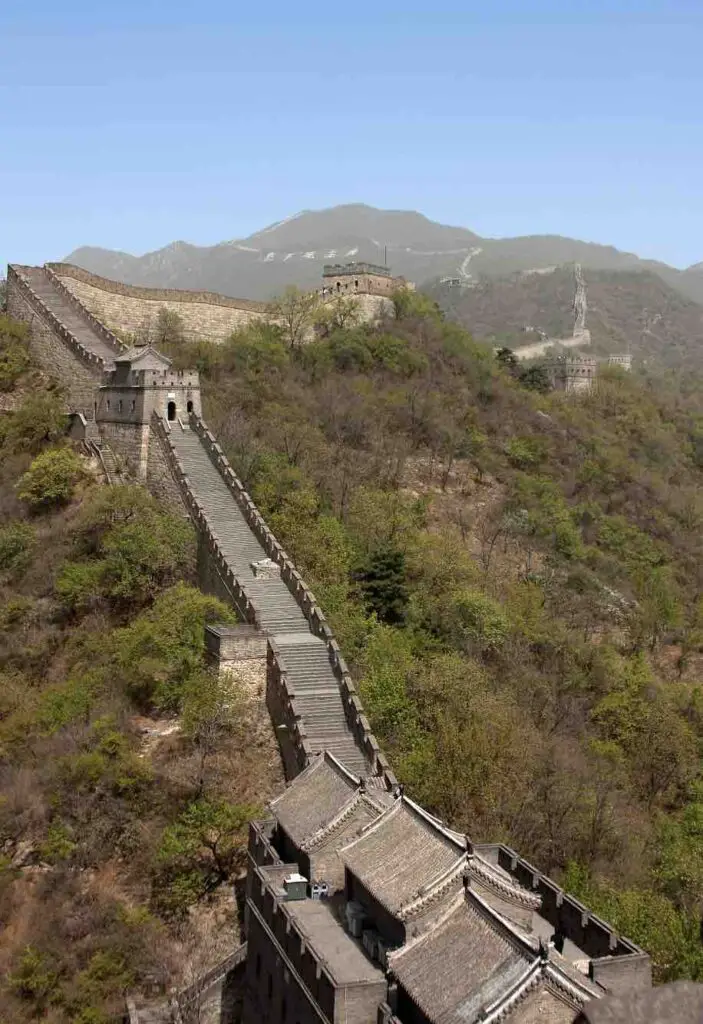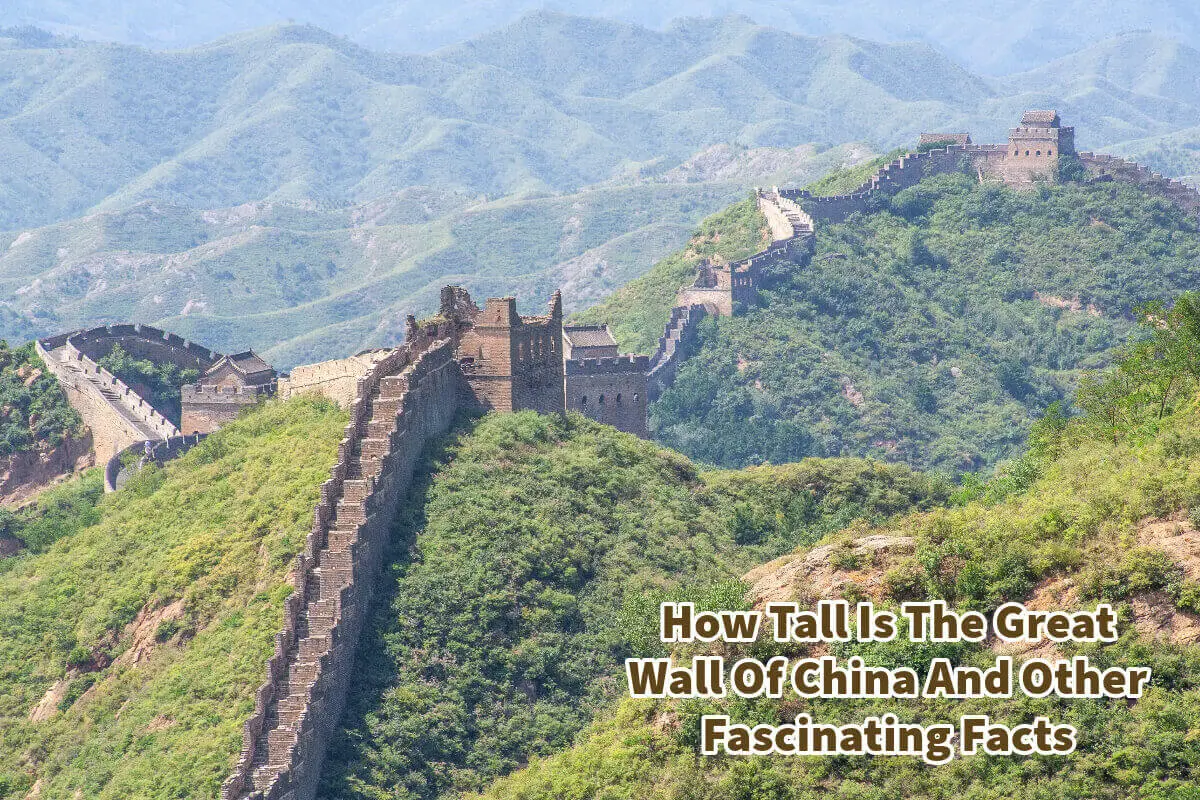The Great Wall of China has long captivated the imaginations of history enthusiasts, tourists, and scholars alike. The Great Wall is truly a symbol of China and all China could accomplish by building the wall.
With its intricate design, massive scale, and historical significance, the wall is more than just an architectural marvel. It symbolizes China’s strength, culture, and technological prowess. Here, we delve into various aspects of this awe-inspiring structure, beginning with its height and moving on to its various features and why it holds unparalleled significance even today.
Table of Contents
- The Height Of The Great Wall Of China And Other Intriguing Details
- Passes: The Strongholds Of The Great Wall
- Signal Towers: The Communication Hubs Of The Great Wall
- The Wall Itself: The Core Defensive Line
- Why The Great Wall Matters
- Related Questions
The Height Of The Great Wall Of China And Other Intriguing Details
The Great Wall of China is an awe-inspiring marvel with a storied past. Visiting the wall in person offers an incredible opportunity to witness its architectural complexity and grasp its impressive height.
Join us as we explore some essential facts about the Great Wall of China and their significance.

Height Of The Great Wall
The Great Wall of China, an architectural marvel and historical treasure, stands as a symbol of both the vast capabilities and the enduring spirit of human endeavor. Stretching over 13,000 miles, it is renowned for its immense length and the incredible feat of engineering it represents.
Constructed over several centuries by various Chinese dynasties, the wall was primarily built to defend against invasions and raids. Its towering presence, weaving through deserts, mountains, and plains, tells a story of a civilization’s struggle, resilience, and artistic mastery.
The height of the Great Wall varies significantly, reflecting the diverse terrains it traverses and the distinct periods of its construction, with some sections reaching up to 25 feet. This monumental structure not only showcases the historical might of China but also serves as a poignant reminder of the enduring human spirit.
Average Height
The Great Wall is not uniformly tall along its entire length. The wall’s average height is about 7.8 meters (25.6 feet).
Variation In Height
The height can significantly vary depending on a particular area’s topography and strategic needs. In some locations, the wall can rise to 14 meters (46 feet).
Height At Sea Level
When we come to the segments at or near sea level, the height of the wall ranges from 6 to 7 meters (20 to 23 feet).
Highest And Lowest Points
The highest section of the Wall is the Huanglouyuan Section, situated at an altitude of about 1,439.3 meters (4,722 feet). On the other hand, the Laolongtou Section is the lowest point, standing just above sea level.
Passes: The Strongholds Of The Great Wall
Passes were strategic points along the wall, typically at intersections with essential trade routes.
Structure Of The Passes
They were heavily fortified, with the ramparts faced with bricks and stones and filled with dirt and crushed stones. The bastions at these passes could measure up to 30 feet high and 13 to 16 feet wide at the top.
Interior Of The Passes
Inside the passes, there were ramps for horses and ladders for soldiers. The interior also featured a yuqiang, a low wall about 3 feet high to prevent falls.
Gates And Parapets Of The Great Wall
The gates within the passes served multiple purposes. They were entry and exit points and strategic locations where troops could be deployed quickly. These gates were usually fortified with a wengcheng, a parapet that shielded the gate from direct assault.
Additional Lines Of Defense Of The Great Wall
Beyond some of the more strategically positioned wenches, there was an additional layer of protection, the lurching, often topped with a watchtower.
Signal Towers: The Communication Hubs Of The Great Wall
The signal towers on the Great Wall would undermine its function as a communication hub. Let’s delve deeper into the features and roles of the signal towers in this iconic structure.
Design Of Signal Towers
Signal towers, or beacons, were usually built on hilltops for maximum visibility. These towers had multiple levels, the lower ones serving as quarters for soldiers and storage areas.
Communication And Signal Tower
These towers were critical for military communications. Signals were sent using various methods, including fires or lanterns at night and smoke signals during the day. Other means like raising banners, clappers, or firing guns were also used.
The Wall Itself: The Core Defensive Line
The wall itself is at the core line of defense for China. The wall can vary. In its width and materials.
Width And Materials
The wall’s width at the base typically measures 21.3 feet and narrows to 19 feet at the top. Depending on the availability of materials, different sections were constructed using tamped earth, adobe bricks, or a mixture of brick and stone.
I have seen sections of the Great Wall of China in many different parts of China. When you see different sections of the wall, you very quickly understand that the different sections of the walls can have different materials. This is because the builders had to adapt to what was locally available.
Adaptive Construction
In some parts, the wall used natural barriers like cliffs and rivers, integrating them into its structure, thus making it a part of the natural landscape.
Why The Great Wall Matters
Many people may wonder why the Great Wall of China matters. Here are some of the ways that the Great Wall of China matters.

Symbol Of National Unity
The Great Wall is not merely a physical barrier; it’s a symbol of national unity and a testament to the collective human endeavor.
Technological Marvel
The construction techniques, the use of varied materials depending on the region, and the advanced fortifications manifest the technological capabilities of the period.
Strategic Importance
From a military standpoint, the wall served as a line of defense and a means of control over trade routes and population movement.
Cultural Heritage Of China
Today, the wall is a monument to Chinese culture and its rich history. It’s a heritage site that teaches us about ancient civilizations, their way of life, and their approach to problem-solving and engineering.
Modern Relevance Of The Great Wall
In today’s global landscape, where physical walls are less significant due to technological advancements, the Great Wall stands as a reminder of how long humans will go to protect and preserve their way of life.
The Great Wall – A Window Into The Past
For historians and archaeologists, the wall offers invaluable insights into the socio-political climate of ancient China, making it a living textbook of sorts.
The Great Wall of China is not just a wall. It’s a complex and intricate system that encapsulates the Chinese people’s ingenuity, resourcefulness, and resilience over the centuries.
Today, The Great Wall is a feat of extraordinary engineering and a symbol of a civilization’s legacy and aspirations. It is a part of our global heritage that teaches us as much about human capability as it does about the historical context in which it was built.
At A Bus On A Dusty Road, we talk about history, travel, life, sailing, and ex-pat living. We are all about “Living Life As A Global Citizen.” We explore social, cultural, and economic issues and travel.
We would love to have you be part of our community. Sign up for our newsletter to keep up-to-date by clicking here. If you have any questions, please contact me, Anita, by clicking here.
Listen to our Podcast called Dusty Roads. You can find it on all major podcast platforms. Try out listening to one of our podcasts by clicking here.
Subscribe to our A Bus On A Dusty Road YouTube Channel with great videos and information.
Related Questions
How Long Did It Take to Build the Whole Great Wall of China?
The Great Wall of China took over 2,000 years to build. The building spans many Chinese Dynasties for about 22 centuries. The construction of the wall ended in the Ming Dynasty in 1644. The Great Wall is one of the largest human-made construction projects globally; it is over 21,196 kilometers or 13,171 miles. There are over 25,000 watchtowers scattered throughout the Great Wall structure.
You can read more about How Long Did It Take to Build the Whole Great Wall of China? by clicking here.
What Is The Meaning Of Koi Fish To The Japanese Culture?
In Japan, the koi fish symbolizes luck, prosperity, good fortune, strength, perseverance – everything good. The Koi fish symbol is very closely associated with the Japanese cultural identity. The word ‘Koi” is a Japanese word that means carp fish.
By clicking here, you can discover What Is The Meaning Of Koi Fish To The Japanese Culture?
Why Sailing Is The Ideal Team Building Exercise? 8 Reasons
Sailing is an ideal team-building exercise as it naturally fosters many things that team building does, such as better communication, working together, building a team, problem-solving, building relationships, teaching leadership, and improving productivity. Sailing is also a sport that is just plain fun and filled with many great memories.
By clicking here, you can discover Why Sailing Is The Ideal Team Building Exercise? 8 Reasons.


